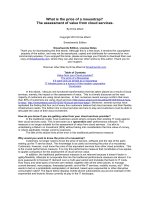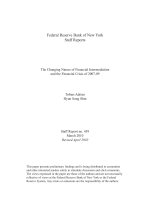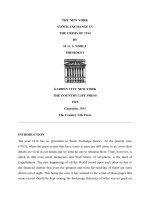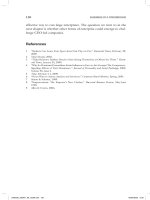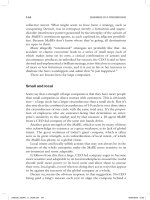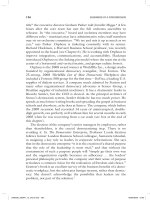Business at a Crossroads The Crisis of Corporate Leadership_1 ppt
Bạn đang xem bản rút gọn của tài liệu. Xem và tải ngay bản đầy đủ của tài liệu tại đây (724.33 KB, 22 trang )
Business at a Crossroads
9780230_230941_01_prels.indd 1 09/09/2009 09:58
This page intentionally left blank
BUSINESS AT A
CROSSROADS
The Crisis of
Corporate Leadership
Tom Lloyd
9780230_230941_01_prels.indd 3 09/09/2009 09:58
© Tom Lloyd 2010
All rights reserved. No reproduction, copy or transmission of this
publication may be made without written permission.
No portion of this publication may be reproduced, copied or transmitted
save with written permission or in accordance with the provisions of the
Copyright, Designs and Patents Act 1988, or under the terms of any licence
permitting limited copying issued by the Copyright Licensing Agency,
Saffron House, 6–10 Kirby Street, London EC1N 8TS.
Any person who does any unauthorized act in relation to this publication
may be liable to criminal prosecution and civil claims for damages.
The author has asserted his right to be identified as the author of this work
in accordance with the Copyright, Designs and Patents Act 1988.
First published 2010 by
PALGRAVE MACMILLAN
Palgrave Macmillan in the UK is an imprint of Macmillan Publishers Limited,
registered in England, company number 785998, of Houndmills, Basingstoke,
Hampshire RG21 6XS.
Palgrave Macmillan in the US is a division of St Martin’s Press LLC,
175 Fifth Avenue, New York, NY 10010.
Palgrave Macmillan is the global academic imprint of the above companies
and has companies and representatives throughout the world.
Palgrave® and Macmillan® are registered trademarks in the United States,
the United Kingdom, Europe and other countries.
ISBN-13: 978–0–230–23094–1
This book is printed on paper suitable for recycling and made from fully
managed and sustained forest sources. Logging, pulping and manufacturing
processes are expected to conform to the environmental regulations of the
country of origin.
A catalogue record for this book is available from the British Library.
A catalog record for this book is available from the Library of Congress.
10 9 8 7 6 5 4 3 2 1
19 18 17 16 15 14 13 12 11 10
Printed and bound in Great Britain by
CPI Antony Rowe, Chippenham and Eastbourne
9780230_230941_01_prels.indd 4 09/09/2009 09:58
This book is dedicated to the memories of my
mother Maggie, my sister Judy, and two great
friends, Peter Bielby and Ray Heath
9780230_230941_01_prels.indd 5 09/09/2009 09:58
This page intentionally left blank
vii
Contents
Acknowledgements xi
Introduction
1
Refer
ence
11
P
ART I What ails big business
13
1
What people want
15
Self-r
espect is a primary good
17
Fr
ee
19
Fair
20
Reasonable
21
Decent
24
Power and powerlessness
26
Good work
29
The ar
gument so far
30
Refer
ences
30
2
A feudal heritage 31
A cat ponders a king 31
Business is natural
32
Early trade
34
The precursors of companies 35
The English East India Company 37
From mercantilism to capitalism 39
The Industrial Revolution
41
An accidental bir
th
42
The birth environment 43
Medieval tournaments 45
The evolutionary puzzle 47
The ar
gument so far
48
Box: Hudson’s Bay Company 48
References 50
9780230_230941_01_prels.indd 7 09/09/2009 09:58
viii CONTENTS
3 The steam-age corporation 51
Why the MuBE emerged 52
Why the MuBE thrived
56
Chandler’s contribution
66
The argument so far 67
Box: Vickers-Armstrongs 67
References 68
4
The decadent corporation
69
Justice as fair
ness
69
Gr
owing inequality
72
Mor
e than fair shares
78
T
ARP restrictions on executive pay
79
The gathering stor
m
82
Bar
riers to reform
83
A danger
ous decadence
85
The ar
gument so far
86
Refer
ences
87
5
Not so much gr
eed
88
Gr
eed 88
Asset-skimming 92
An unwholesome alliance 93
An unhappy coincidence
95
The cult of leadership 98
The buck and the bucks stop here 102
The argument so far 102
Refer
ences
103
6
The myth of leadership
104
The CEO system
105
The management ideas market
107
The CEO as principal and conductor
109
Systemic risks
111
For
tunes from good fortune
114
The CEO as ambassador
115
Leaders and leadership
116
Pr
ogress report
119
The ar
gument so far
119
Refer
ences
120
9780230_230941_01_prels.indd 8 09/09/2009 09:58
CONTENTS ix
PART II Reforming big business 121
7
Leaderless competitors
123
Roads not taken
124
A fractur
ed landscape
127
Box:
Patches on landscapes
128
Phase transition
130
The pover
ty of strategy
132
New r
oads
135
Linux 135
Wikipedia 139
Stewards, seeders, guardians 142
The ar
gument so far
143
Refer
ences
143
8
The adaptive challenge
145
The question of purpose
145
Soul and community
148
T
oo few women
150
Feminine management
153
The ar
row and the spiral
156
The female advantage
157
Talent 157
Moderating macho 158
Risk 158
Ethics 158
Box: Ethics and gender 159
Pay 159
The promise of women 160
The ar
gument so far
160
Refer
ences
161
9
Size and shape
162
Real business
163
Small and local
164
Power with
165
Box:
From an Acorn
167
The parasite’s strategy
169
Par
tnership problems
170
Y
ielding power
174
9780230_230941_01_prels.indd 9 09/09/2009 09:58
x CONTENTS
Creative conversation 175
Partnership enterprise 176
The ar
gument so far
177
Refer
ences
177
10
Corporate r
eformation
178
The Individualized Corporation
178
The r
egents committee
182
Corporate democracy
185
Numbers that nudge
187
Open-book management 188
Measuring CEO performance 190
Redeeming the corporation 191
Box:
Semco’s steps to democracy
193
Refer
ences
193
Index
194
9780230_230941_01_prels.indd 10 09/09/2009 09:58
xi
Acknowledgements
This book has been germinating for several years during which time the
way I see business has been influenced by many people. They include
two “turnips,” as my wife calls them (they’re Swedes), my friends and
ex-colleagues, Karl-Erik Sveiby and Ronald Fagerfjall, John Curtis,
Andrew Bull, Anne Murphy, Jon May, Anne Deering, Tony Rowland,
Danny Barr, James Ramsden, Mike Hainsworth, Adrian Pryce, Richard
Miller, Peter McAllum, Peter Robinson, and David Hurst. Thanks to all
of you for the stimulating conversations that have led me to conclusions
some of you will, no doubt, disagree with.
A number of other people have helped me to put what I have learned
into the words that follow by contributing ideas and reviewing and
criticizing drafts. They include Peter Duffy, Rich Foggio, Vince Darley,
John McNulty, John Stansell, and Neil Marshman. Very special thanks
go to my two most diligent and helpful reviewers, James Page and
Antonie Reichling.
Thanks also to Palgrave Macmillan’s Stephen Rutt, for taking a
chance with the book, and his colleague Eleanor Davey Corrigan, for
her helpful comments and guidance.
I would also like to thank Rose Lewis for her light and accurate
editing.
9780230_230941_01_prels.indd 11 09/09/2009 09:58
This page intentionally left blank
1
Introduction
The evolution of the liberal capitalist system ground to a halt in 2007–
08. The default of the apocryphal subprime mortgage borrower in
America’s mid-west, a mere flutter of butterfly wings, caused a hurri-
cane of fear to rage through the securitized debt markets and sent the
world’s banking system into cardiac arrest.
With the help of blood transfusions from central banks, the system
regained a semblance of life, but emerged from the trauma a pale
shadow of its former self. The hunger for ever riskier lending was trans-
formed into extreme risk aversion. Banks, fearing their peers were even
more exposed than themselves to the subprime securities market,
stopped lending to each other and lenders dependent on the interbank
market collapsed.
When the troubles spread to Main Street a bonfire of all Wall Street’s
vanities engulfed “the Masters of the Universe,” as novelist Tom Wolfe
had dubbed investment bankers and securities dealers at the time of a
less dramatic crash two decades earlier. What were they thinking? That
“securitizing” loans to people on welfare made them less risky? That
making a market in risk and moving it about would reduce its virulence?
That the magic wand of economic growth would transform sows’ ears
of subprime debt into prime silk purses?
In the firestorm of recrimination and accusation that followed the
crash, the trust ordinary people had in the powers that be – those who
had been running the liberal capitalist system, company chief executive
officers (CEOs) and their Wall Street allies – and their tolerance of their
astronomical pay packets, were consumed.
The system was broken. Its fragility was exposed. There was a flaw in
the complicated array of risk management devices and securities those
erstwhile masters of the universe had designed to juggle the gravely
mis-measured risks of their lending binge.
Perhaps there was a flaw in liberal capitalism itself.
It was up to governments and central banks, which were held partly
to blame for what, with hindsight, was seen as their reckless deregula-
tion of financial markets before the crash, to deliver first aid. It is up to
9780230_230941_02_intro.indd 1 09/09/2009 10:07
2 BUSINESS AT A CROSSROADS
us, the ultimate architects of political-economic systems, to decide the
kind of society we want to live in, and the kinds of organization we want
to work for.
A vote, whether cast with hands or feet, is no small thing, and at a time
like the present, when long-held beliefs and previously unquestioned
assumptions can no longer be taken for granted, a vote becomes a very
large thing. In choosing political parties, by ticking boxes, and choosing
the kinds of organization we work for, by walking away from some and
toward others, we can reshape our society and its institutions.
Let us choose reform and restoration. The alternative is too awful to
contemplate. I fear Yeats’s Second Coming; the second coming of socialism.
The return, to the political debate, of Marx’s “blank and pitiless” slogan:
“From each according to his ability, to each according to his need.”
It would be a rational choice in many ways. The system that failed
was manifestly unfair. It was producing gross and rapidly growing
inequalities. Ordinary people were already bemused and angered by the
huge sums paid to hedge fund managers, investment bankers and CEOs
before the crash. They were incensed by the enormous “golden para-
chutes” paid to the ex-CEOs whose strategies had contributed to the
meltdown. They became apoplectic when, faute de mieux, their money
had to be used to rescue the banks that had precipitated the crisis.
The financial crisis also exposed a profoundly unfair asymmetry in
the system. In a rising market, bank lending magnifies gains which
enrich a few hedge fund managers, investment bankers and top level
executives. But in a falling market, it magnifies losses which are carried
by everyone when banks are bailed out by the taxpayer. In this way,
boom and bust act like an inequality ratchet. Gains during the boom are
captured by the privileged few, losses during the bust are paid for by
everyone and, cycle after cycle, inequality grows.
For voters made aware by the bailout that they have been played as
mugs in a classic “heads I win, tails you lose” game, it would be folly to
allow the game to continue, and rational to substitute neo-socialism for
the liberal capitalism that had, supposedly, led to the unfairness.
Rational, but not reasonable.
Something must clearly be done about this unfairness, but to blame
liberal capitalism for the inequality and financial crisis, and to vote in a
socialist government would be to throw the baby out with the bath-
water; to shut Pandora’s box before hope emerges. Liberal capitalism
has proved its worth. Few now dispute that free markets protected by
vigilant antitrust and other forms of regulation are the best system for a
society that places a high value on economic well-being.
9780230_230941_02_intro.indd 2 09/09/2009 10:07
INTRODUCTION 3
Vigilant regulation is vital, because there are worms at the cores of
free markets. Sir Karl Popper’s “paradox of democracy” was that when
democracy is too free, tyranny can emerge. When markets are too free,
monopolies, inequality and financial instability can and do emerge.
Political, economic, biological and other complex systems all have
fundamental flaws of this kind; seeds of their own destruction, in subsys-
tems, tendencies and propensities, which, like cancers, can grow out of
control and suborn, take over or otherwise jeopardize the survival of
their host systems. That’s why liberal democracies need constitutions
and markets need regulation.
Recent events and developments suggest liberal capitalism harbors
two dangerous seeds of self-destruction; growing inequality, which
undermines the political consensus that sustains the system, and a
tendency for markets to spiral out of control. The economist, John
Maynard Keynes, suggested that economic activity was partly driven by
alternating waves of irrational optimism and pessimism. Some 70 years
before the 2007 subprime crisis Keynes said, in The General Theory of
Employment, Interest and Money, most of our decisions “to do some-
thing positive … can only be taken as the result of animal spirits – a
spontaneous urge to action rather than inaction, and not as the outcome
of a weighted average of quantitative benefits multiplied by quantitative
probabilities.” Some suggest it’s these animal spirits, their effects magni-
fied by positive feedback from self-fulfilling prophesies, that drive
business cycles.
It’s up to us to ensure these seeds of self-destruction in liberal capi-
talism are brought under control.
My prescription is reculer pour mieux sauter; to step back to jump
forward more strongly. We need to turn liberal capitalism’s clock back
to a time before its seeds of self-destruction began to take over.
Evolution in nature sometimes works this way in a process known as
“neoteny” (“holding youth”). We are the creatures of neoteny. Our
rounded, bulbous cranium containing our large brain resembles that of
a foetal ape. Subsequent ape brain growth is slower than ours, so the
cranial vault is smaller and lower in an adult. We acquired our large
brains by retaining rapid foetal growth rates.
The human face – distinguished from the faces of other primates by
its straight profile, small jaws and teeth, and weak brow ridges – resem-
bles the face of a juvenile ape. The resemblance fades as the ape’s jaw
grows, relative to the rest of the skull, to produce the adult ape’s muzzle.
The foramen magnum, the hole in the mammalian skull from which the
spinal cord issues, is underneath our skull, pointing downwards, as in
9780230_230941_02_intro.indd 3 09/09/2009 10:07
4 BUSINESS AT A CROSSROADS
the embryos of other mammals. This means we look forwards, when we
stand upright. As other mammals mature, the foramen magnum rotates
and ends up pointing backwards, so that the animal looks forwards
when standing on all fours.
The Microsoft Windows operating system incorporates a reculer
pour mieux sauter option. If your computer keeps crashing, or begins to
run agonizingly slowly, because it has acquired viruses, worms or other
internet pathogens, System Restore allows you to restore the machine
to a previous known working state. Files and data, such as word-
processing documents, spreadsheets, music and images, remain intact,
but the operating system itself reverts to its state at an earlier time,
before things began to go wrong.
We must do a System Restore on liberal capitalism.
Something of the kind has already occurred in the new regulations
for banks and capital markets following the 2008 financial crisis. In a
sense, they have restored liberal capitalism’s financial subsystem to its
mid-1980s state, before the deregulation and subsequent globalization
of the financial services industry.
This book advocates the reformation of another creature of liberal
capitalism, the large, limited liability joint stock company, some of the
features, practices and appetites of which I believe lie at the heart of
liberal capitalism’s malaise.
In their new “global” guise these institutions appear to exemplify
liberal capitalism. They are the overwhelmingly dominant business
organizations, and most of us are directly or indirectly employed by
them. They seem to be integral to liberal capitalism, or at any rate capi-
talism. The system seems inconceivable without them.
So prominent and powerful are they that it is easy to forget their
relatively recent origins. The company as we know it, only assumed its
modern form in the mid-19th century and remained a minor player in
business until the early 20th century. But since then, this form of enter-
prise, cobbled together with a structure borrowed from the military,
practices and habits inherited from mercantilist trading companies, and
hungers derived from the entrepreneurial businesses and partnerships
that drove the Industrial Revolution, has been astonishingly successful.
The modern world is in many respects its creature.
But it has begun to show clear signs of decadence.
Enron, WorldCom, Tyco and Parmalat are a few of the names that
had tainted the reputation of “big business” with a whiff of fraud and
corruption long before the big crash. These scandals led to the Sarbanes-
Oxley Act in the U.S., and similar laws and codes of practice elsewhere.
9780230_230941_02_intro.indd 4 09/09/2009 10:07
INTRODUCTION 5
That such regulations were deemed necessary in nations wedded to
laissez-faire economics reflected a concern that, when left to their own
devices, big companies tend to behave badly and it was, therefore,
necessary to curtail their liberty.
The generally more critical view of business has also been evident
recently in the accusations by governments, fiscal authorities and
commentators that companies that engage in aggressive tax planning
(tax avoidance, the opportunities for which have been increased by
globalization and tax competition between national governments for
foreign investment) are behaving unethically, and not paying their dues
to the societies in which they operate.
But much the clearest and, in my view, the most worrying sign that
the large, publicly listed, limited liability, joint stock company has entered
a decadent stage where its behaviour is diverging from commonly
accepted standards, is the executive pay explosion. Let us be clear about
this issue from the outset. There is no remotely conceivable justification,
economic or otherwise, for the CEOs of our largest companies to be
paid several hundred times the average pay of their employees.
I imagine readers gasping in disbelief. Surely this is a typing error?
But no. At the top of the bull market in 2000, the CEOs of the 500
largest U.S. companies were paid (“earned” is entirely the wrong word)
on average over $500,000 for every $1,000 paid on average to the rest
of their employees. The subsequent market crash (a minor blip,
compared to what was to come later), and new reporting rules requiring
companies to account for stock options as expenses, led to a brief reduc-
tion in the multiple subsequently, but the average multiple for Fortune
500 companies was 350 in 2005, and rising.
There’s a furtiveness about executive pay. Like a spider caught in the
light, it freezes and sometimes even retreats, when it becomes a focus of
attention, but creeps up again when no one is looking. It froze and
retreated after the 2008 crash, in response to public outrage at the huge
severance packages and pensions paid to former CEOs of banks who
had bet the farm on subprime debt.
CEOs are not stupid. They can’t possibly believe they are actually
worth what they’re paid. They know there’s no link between CEO pay
and corporate performance. So why do they demand such enormous
pay packages and, more importantly, why do their shareholders accede
to their demands? These questions lead directly to the rottenness at the
core of the modern corporation. But greed isn’t the answer. To explain
the CEO pay explosion as a consequence of insatiable human greed is
to miss the point entirely.
9780230_230941_02_intro.indd 5 09/09/2009 10:07
6 BUSINESS AT A CROSSROADS
CEOs aren’t abnormally greedy. They simply accept the good
fortune that has brought them to a place where huge rewards are there
for the taking, ignore protests in the popular press about troughing and
fat cats and try to ensure that their pay remains competitive. As one
German CEO, relatively lowly paid by Anglo-Saxon standards, is said to
have put it: “I know I am overpaid, but the benchmarks say I’m not
overpaid enough.”
It is an institutional greed; a product, not of human avarice, but of the
way hierarchical corporate organizations concentrate power in the hands
of individuals and create a “CEO class” isolated from market disciplines,
where remuneration is decoupled from work and economic value added,
and CEO pay packets chase each other upwards in a never-ending spiral.
Let us be clear about another thing from the outset. Pay and power are
inextricably linked. It would make no sense for shareholders to pay their
CEOs huge amounts of money if they didn’t also assign to them huge
amounts of power. Only omnipotence can justify modern CEO rewards
and omnipotent CEOs can’t pass the buck when things go wrong.
The consequent emergence of what are in modern times unprece-
dented inequalities of power, income and wealth, marks the beginning
of a new and alarming chapter in the evolution of liberal capitalism. I
will argue that, fortunately for liberal capitalism, the explosion in execu-
tive pay is not a natural outcome of the system. It is an aberration that
can be corrected. It must be corrected, because it is the Achilles heel of
modern capitalism. It is so obviously and so offensively unfair that, if it
continues, the sense of fairness and justice that sustains the liberal
democratic consensus will be undermined.
Growing inequalities within liberal capitalist societies and their
business organizations undermine not only the general consensus on
which these societies rest, but also the countless contracts of employ-
ment and association that comprise that consensus.
Partly because of the executive pay explosion, modern companies
are seen by their employees and prospective employees as profoundly
unfair organizations that do not recognize or reward ability and dili-
gence proportionately. Why this should be so is something of a puzzle.
Institutions that compete with each other in a free market should realize
the vital importance of paying fair rates for goods and services rendered,
and the market itself should penalize those that don’t. But disparities in
pay – between men and women, ethnic groups and, most conspicu-
ously, between middle and senior managers and “C-level” executives
(CEO, CFO, COO, and so on) – persist. Whatever the reasons for
them, these huge disparities in income are seen as unfair and hang like
9780230_230941_02_intro.indd 6 09/09/2009 10:07
INTRODUCTION 7
dark clouds over company cultures, breeding resentment in those who
have to get by on a tiny fraction of their leaders’ incomes.
It is not the fact of differences in pay that is controversial; it is the
extravagance. It is simply impossible for reasonable people to believe
that their CEOs, several of whom are sacked with multi-million-dollar
severance packages each year for incompetence and who, as a breed, are
notorious for destroying shareholder value by paying too much for
acquisitions and – in their pursuit of targets linked to their incentive
plans – for taking too many risks, could be worth such huge rewards.
The second problem, related to the first, that people have with large
companies, is the deterioration in the so-called “work–life balance.”
Working for large, complex organizations has always been demeaning,
since Henry Ford turned his employees into cogs in a machine. More
recently it has also become intolerably demanding. In today’s intensely
competitive business world CEOs have to crack the whip harder and
harder to get their numbers to the point where their incentive plans kick
in. The result is that it is becoming difficult, if not impossible, for ambi-
tious managers to maintain a full and fulfilling family and social life.
It is here, in the unfairness of large companies and the excessive
demands they make on employees, that the System Restore, reculer
pour mieux sauter possibility lies. People voting with their feet, moving
from one kind of organization to another, is the engine of the evolution
of the corporate form. For lack of anything better, we have put up with
the unfair and demanding organizations most of us work for, but we are
unlikely to do so for much longer. People, particularly those exception-
ally able people large companies fight tooth and nail with each other to
employ in the so-called “war for talent,” are now realizing that recent
technological, economic and social changes give them more options.
Nowadays, they can leave organizations in which they feel uncom-
fortable with less fear of becoming destitute and they can form, join or
become associated with smaller, looser organizations that offer them
work and types of association that suit them better.
Once their economic needs have been met people will seek the kinds
of work and types of association that appear, to them, most likely to
satisfy their emotional needs and particularly their hunger for self-
respect. I believe it is this human hunger for self-respect, rather than
globalization or technological change, that is driving corporate evolu-
tion. Like natural forms, corporate forms co-evolve with the environ-
ment in which they compete for resources. Now that able, hard-working
people, the most important business resources, realize they have choices,
they will leave organizations that deny them self-respect.
9780230_230941_02_intro.indd 7 09/09/2009 10:07
8 BUSINESS AT A CROSSROADS
This book explains why capitalism’s main economic agent, the large
CEO-led, limited liability joint stock company, is in dire need of funda-
mental reform and suggests some steps companies could take to improve
their adaptation to today’s environment. It focuses on the U.S. and the
U.K., because it is in these countries that the problems are most acute,
and the decadence of companies is most advanced.
There are three protagonists in my story. The first is the company
that wants to hire able people who respect themselves, because it knows
they are more self-confident and creative than wage slaves. The second
is the individual who, as a voter, wants a society that is fair as well as free
and, as a worker, yearns for a career that is fulfilling and rewarding
without demanding so much commitment that she or he feels inade-
quate as a partner, parent, friend and human being. The third is less
easy to describe. It is the modern company’s as yet inchoate nemesis –
the new breed of enterprise that will challenge and possibly replace the
company if it fails to reform itself.
The first step in a System Restore process is to choose an earlier date
to which to return the system or institution. This is no easy task because,
although the problems themselves (the unfairness and excessive demands)
are clear enough, their causes are shrouded in the mists of the past. We
must go right back to the origins of the institution itself to understand
what corporations are and why and in what ways they became decadent.
There is no mystery about why trade and business developed. It was
because there are synergies in exchanges of goods and services, and econ-
omies in specialization. Business organizations were developed to conduct
business and trade, because there are economies in the coordination of
business activities and synergies in cooperation between specialists.
But there is no ideal business form or model of association. Forms
and types of association emerge in response to new challenges and will
fall into disuse when changes in their environment make them less “fit”;
when their initial virtues become, or are replaced by, vices. Each form
has what evolutionists call a unique “environment of evolutionary
adaptedness” (EEA) and tends to become less fit as its current environ-
ment diverges from its EEA.
Today’s dominant form of business organization emerged in
response to the environment of the late 19th century, so it’s no surprise
it has run into trouble in the environment of the early 21st century.
Much has changed over the past 150 years. Markets have become more
efficient, a global economy has emerged and new technologies have
changed the nature and intensity of competition, and created space for
new enterprise experiments and business models.
9780230_230941_02_intro.indd 8 09/09/2009 10:07
INTRODUCTION 9
Most important, the attitudes, outlooks, aspirations and emotional
needs of able individuals have been changed profoundly in the past two
decades or so by important social and economic developments. These
include the unilateral repudiation by most employers of the old “loyalty
for security” psychological contract (keep your nose clean and close to
the grindstone, and you have a job for life); the re-emergence of the
market rather than the organization as the mechanism for valuing
human worth and allocating human resources; the opportunities for
self-employment created by the internet and the disaggregation of
business through outsourcing and other kinds of association; and more
recently, the sea change in the perceived cost–benefit profiles of employ-
ment, versus self-employment caused by the recession. (Recessions
always eject large numbers of people from companies and not all of
them return when growth resumes.)
The importance of these changes lies not so much in themselves, as
in the options they offer able people to satisfy their hunger for self-
respect. Just as slaves and serfs had to resign themselves to their status
when there was no prospect of freedom, so wage slaves raised no objec-
tions to their economic serfdom when there was no obvious alternative.
People are beginning to realize that there is an alternative now. Econ-
omic serfdom has become voluntary.
The human hunger for self-respect has led to the gradual diffusion
throughout the world of a system of government we call liberal democ-
racy. It has been a slow process and, even now, liberal democracy is not
universal. But the trend is clear and it seems for the most part to be
irreversible. Self-respect is a “primary good,” as John Rawls
1
called it,
and history suggests that, in the political arena at any rate, it’s maxi-
mized for the mass of ordinary people within a liberal democracy.
This same hunger for self-respect requires changes in the forms of
organization and the types of association in which, and with which,
people will come together in future to combine their talents and abili-
ties in concerted efforts to create wealth.
This book has two parts. The first six chapters focus on what ails big
business. The final four chapters focus on what can be done to reform it.
Part I, “What ails big business,” begins in Chapter 1 with an invita-
tion to readers to redesign work; to ask themselves how, in an ideal world,
they think work should be managed or organized and how, in an ideal
world, they think that the rewards for work ought to be distributed.
Armed with the model extracted from this thought experiment of
the working arrangements most people want, I shall explain, in Chapter
2, why they have so far been denied such arrangements. My approach is
9780230_230941_02_intro.indd 9 09/09/2009 10:07

